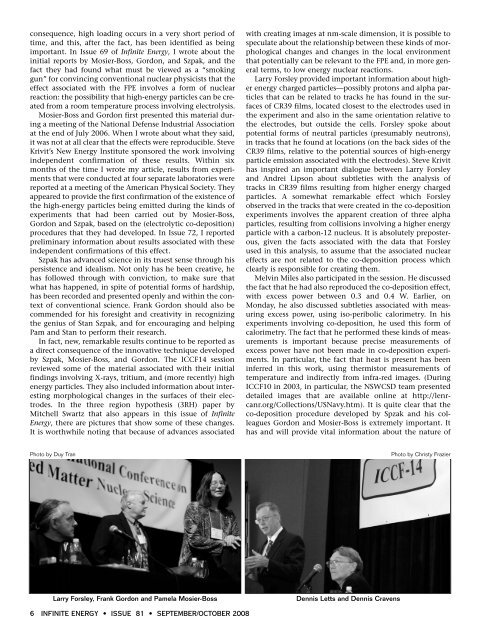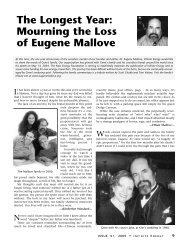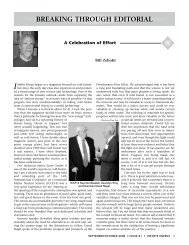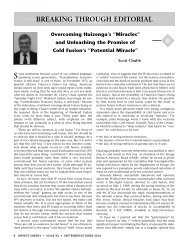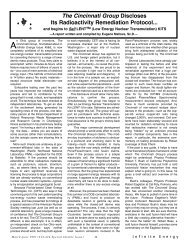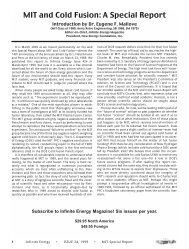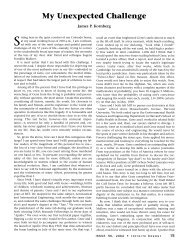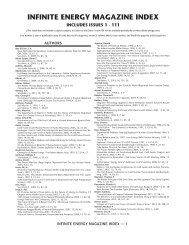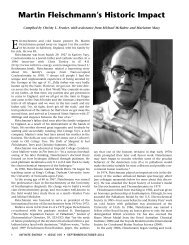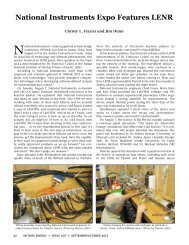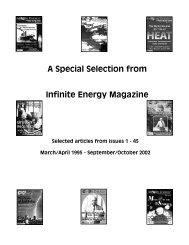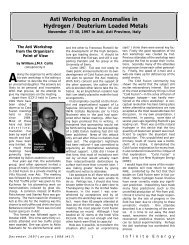Summary of ICCF14 - Infinite Energy Magazine
Summary of ICCF14 - Infinite Energy Magazine
Summary of ICCF14 - Infinite Energy Magazine
You also want an ePaper? Increase the reach of your titles
YUMPU automatically turns print PDFs into web optimized ePapers that Google loves.
consequence, high loading occurs in a very short period <strong>of</strong><br />
time, and this, after the fact, has been identified as being<br />
important. In Issue 69 <strong>of</strong> <strong>Infinite</strong> <strong>Energy</strong>, I wrote about the<br />
initial reports by Mosier-Boss, Gordon, and Szpak, and the<br />
fact they had found what must be viewed as a “smoking<br />
gun” for convincing conventional nuclear physicists that the<br />
effect associated with the FPE involves a form <strong>of</strong> nuclear<br />
reaction: the possibility that high-energy particles can be created<br />
from a room temperature process involving electrolysis.<br />
Mosier-Boss and Gordon first presented this material during<br />
a meeting <strong>of</strong> the National Defense Industrial Association<br />
at the end <strong>of</strong> July 2006. When I wrote about what they said,<br />
it was not at all clear that the effects were reproducible. Steve<br />
Krivit’s New <strong>Energy</strong> Institute sponsored the work involving<br />
independent confirmation <strong>of</strong> these results. Within six<br />
months <strong>of</strong> the time I wrote my article, results from experiments<br />
that were conducted at four separate laboratories were<br />
reported at a meeting <strong>of</strong> the American Physical Society. They<br />
appeared to provide the first confirmation <strong>of</strong> the existence <strong>of</strong><br />
the high-energy particles being emitted during the kinds <strong>of</strong><br />
experiments that had been carried out by Mosier-Boss,<br />
Gordon and Szpak, based on the (electrolytic co-deposition)<br />
procedures that they had developed. In Issue 72, I reported<br />
preliminary information about results associated with these<br />
independent confirmations <strong>of</strong> this effect.<br />
Szpak has advanced science in its truest sense through his<br />
persistence and idealism. Not only has he been creative, he<br />
has followed through with conviction, to make sure that<br />
what has happened, in spite <strong>of</strong> potential forms <strong>of</strong> hardship,<br />
has been recorded and presented openly and within the context<br />
<strong>of</strong> conventional science. Frank Gordon should also be<br />
commended for his foresight and creativity in recognizing<br />
the genius <strong>of</strong> Stan Szpak, and for encouraging and helping<br />
Pam and Stan to perform their research.<br />
In fact, new, remarkable results continue to be reported as<br />
a direct consequence <strong>of</strong> the innovative technique developed<br />
by Szpak, Mosier-Boss, and Gordon. The <strong>ICCF14</strong> session<br />
reviewed some <strong>of</strong> the material associated with their initial<br />
findings involving X-rays, tritium, and (more recently) high<br />
energy particles. They also included information about interesting<br />
morphological changes in the surfaces <strong>of</strong> their electrodes.<br />
In the three region hypothesis (3RH) paper by<br />
Mitchell Swartz that also appears in this issue <strong>of</strong> <strong>Infinite</strong><br />
<strong>Energy</strong>, there are pictures that show some <strong>of</strong> these changes.<br />
It is worthwhile noting that because <strong>of</strong> advances associated<br />
with creating images at nm-scale dimension, it is possible to<br />
speculate about the relationship between these kinds <strong>of</strong> morphological<br />
changes and changes in the local environment<br />
that potentially can be relevant to the FPE and, in more general<br />
terms, to low energy nuclear reactions.<br />
Larry Forsley provided important information about higher<br />
energy charged particles—possibly protons and alpha particles<br />
that can be related to tracks he has found in the surfaces<br />
<strong>of</strong> CR39 films, located closest to the electrodes used in<br />
the experiment and also in the same orientation relative to<br />
the electrodes, but outside the cells. Forsley spoke about<br />
potential forms <strong>of</strong> neutral particles (presumably neutrons),<br />
in tracks that he found at locations (on the back sides <strong>of</strong> the<br />
CR39 films, relative to the potential sources <strong>of</strong> high-energy<br />
particle emission associated with the electrodes). Steve Krivit<br />
has inspired an important dialogue between Larry Forsley<br />
and Andrei Lipson about subtleties with the analysis <strong>of</strong><br />
tracks in CR39 films resulting from higher energy charged<br />
particles. A somewhat remarkable effect which Forsley<br />
observed in the tracks that were created in the co-deposition<br />
experiments involves the apparent creation <strong>of</strong> three alpha<br />
particles, resulting from collisions involving a higher energy<br />
particle with a carbon-12 nucleus. It is absolutely preposterous,<br />
given the facts associated with the data that Forsley<br />
used in this analysis, to assume that the associated nuclear<br />
effects are not related to the co-deposition process which<br />
clearly is responsible for creating them.<br />
Melvin Miles also participated in the session. He discussed<br />
the fact that he had also reproduced the co-deposition effect,<br />
with excess power between 0.3 and 0.4 W. Earlier, on<br />
Monday, he also discussed subtleties associated with measuring<br />
excess power, using iso-peribolic calorimetry. In his<br />
experiments involving co-deposition, he used this form <strong>of</strong><br />
calorimetry. The fact that he performed these kinds <strong>of</strong> measurements<br />
is important because precise measurements <strong>of</strong><br />
excess power have not been made in co-deposition experiments.<br />
In particular, the fact that heat is present has been<br />
inferred in this work, using thermistor measurements <strong>of</strong><br />
temperature and indirectly from infra-red images. (During<br />
ICCF10 in 2003, in particular, the NSWCSD team presented<br />
detailed images that are available online at http://lenrcanr.org/Collections/USNavy.htm).<br />
It is quite clear that the<br />
co-deposition procedure developed by Spzak and his colleagues<br />
Gordon and Mosier-Boss is extremely important. It<br />
has and will provide vital information about the nature <strong>of</strong><br />
Photo by Duy Tran<br />
Photo by Christy Frazier<br />
Larry Forsley, Frank Gordon and Pamela Mosier-Boss<br />
Dennis Letts and Dennis Cravens<br />
6 INFINITE ENERGY • ISSUE 81 • SEPTEMBER/OCTOBER 2008


